This article originally appeared in the July/August 2018 issue of WiFi HiFi Magazine. As we currently deal with the coronavirus pandemic, it has become evident more than ever that having a social media presence is an important way to reach customers, especially when you’re not able to welcome them through your doors in person.

“If you’re not doing it, you might as well close up shop.” That’s the consistent sentiment about participating in social media that was expressed by every industry member with whom I spoke – from manufacturers big and small, to a local independent dealer, and business-to-business (B2B) companies.
It would appear, then, that the short answer to the question posed in the title of this article is a resounding “yes.” But why invest the time, effort, and money, for a social media presence? Is it yet another way to reach customers? What’s required of you? Who will manage it? How much does it cost to make sure your content is actually seen? What’s the return on investment, both in money and time? And is it worth the constant attention to a practice that seems almost inane?
There are so many variables that it’s not surprising many smaller brands simply don’t bother to be involved in social media at all. “I don’t have the time,” and “our business is mainly based on referrals” are two of the most common answers I hear from social media naysayers, who limit their online presence to nothing more than a simple Website.
But the folks with whom we spoke, from across Canada, have all realized value in using this new, albeit sometimes tricky to navigate, medium.

The Power of Social Media
Social media can yield tremendous value for a business, if used effectively. It can help raise a brand’s profile, and guide perception of a company. It can shed light on wonderful community or philanthropic involvements, keep you in touch with customers (and partners), and showcase great products, services, events, and offerings.
You can’t ignore social media as that annoying part of the Web that’s “not for your business.” A CMO Survey predicted that the share of marketing budgets allocated to social media spending would double from 10.7% in 2015 to 23.8% by 2020. Hubspot data from 2012 found that 44.6% of business-to-business (B2B) companies had already, at that time, acquired customer leads via LinkedIn, 35.1% from Facebook, and 31.6% from Twitter. Instagram was only just rising to fame, and has now become a powerhouse for business and personal users, alike.
The market continually shifts, and social media sites differ: the one that will resonate with your customers may not be the same one that is best suited for another business.
Marketing analytics software company TrackMaven’s 2017 Digital Marketing Analytics Performance Report provides insight into which social media platforms work for which channels, noting that consumer goods brands tend to have the most engaging cross-channel social media presence, while B2B companies build their audiences on sites like LinkedIn. But there’s no hard and fast rule.
Consumer goods companies tend to get the biggest social media audience on Instagram, and the smallest on LinkedIn. Their most engaging social network is Instagram, and the least is Twitter.
For retail, the biggest social media audiences tend to be on Instagram, which is also the most engaging social media platform for them. The smallest social media audience is on LinkedIn, and the least engaging social media platform is Pinterest.
Finding the most effective platform for your brand, and a creative way to use it, may take some experimentation. HP became the first brand to reach a million followers on LinkedIn, while GE was one of the first brands to use Facebook Live, which launched in early 2017, for a major event.
Most companies task social media to their marketing teams, and while some allocate advertising dollars, smaller companies can start organically, using social media to generate a presence and personality for the company. This doesn’t mean touting the benefits of your brand – not exclusively or overtly, at least – but to speak openly to an engaged audience about things that matter to both of you, whether that’s music, video, mobile-related topics, or something else entirely.
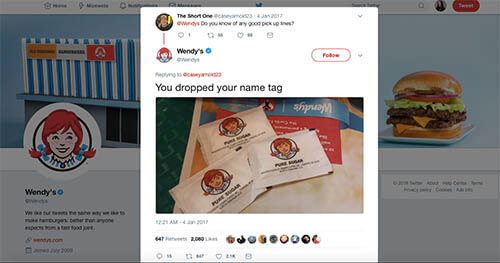
A fun example of a company that “gets” how to use social media is the Wendy’s fast food chain, which has made a name for itself as one of the wittiest brands on Twitter, cleverly roasting random users and rival brands, while promoting its brand in the process. “Can you find me the nearest McDonalds?” one user asked, fishing to receive one of their infamous snarky replies. The response was an image of a trashcan. In another conversation: “What should I get from McDonalds?” asks a woman. “Directions to the nearest Wendy’s” they replied. Whatever the reply, it’s always clever. When a user asked for some good pick-up lines, they posted: “You dropped your name tag” along with a photo of Wendy’s-branded sugar packets, labelled “pure sugar.”
Technology businesses can, and have been, effective as well in their own unique ways. HP uses its Facebook page to share industry news from trusted sources, product promotions, videos, and shareable graphics. Celebrities and “influencers” speak favourably on their behalf, adding an important level of authenticity to the message.

GE adopts an interesting strategy with its Pinterest page, which counts more than 27,000 followers for its 40+ custom boards. One of the most popular series of posts is a play on the popular “Hey girl” Internet memes that typically feature photos of handsome actor Ryan Gosling accompanied by pick-up lines. Instead, GE uses photos of people like Thomas Edison, alongside its own witty science-themed pick-up lines, like “Hey girl, I heard you liked music so I invented the phonograph,” or “Hey girl, our love will burn longer than a tungsten filament in a vacuum-sealed bulb.”
How Your Competitors/Colleagues are Playing in Social Media
For a local independent retailer, gaining followers in the thousands like GE or HP might seem an impossible feat, though it is achievable. With the brand power of the musical Marley family behind it, the House of Marley audio products brand has an impressive 160,000 followers on Instagram, more than half-a-million Likes on Facebook, 1,400 followers on LinkedIn, 11,000 subscriptions to its YouTube channel, and 9,000 followers on Twitter.
But more important than numbers is the level of engagement among that community of fans and followers.
Capital Sound, an Ottawa-based AV retailer and custom integrator, has 1,335 Instagram followers who check out product photos, video tours, and pictures from industry and other related events. Owner Antonio Romeo says being involved on sites like Instagram is a way of putting their hand out in the crowded world wide web and saying ‘hey, I’m here!’ He uses social media to increase brand awareness and communicate with current and potential clients.
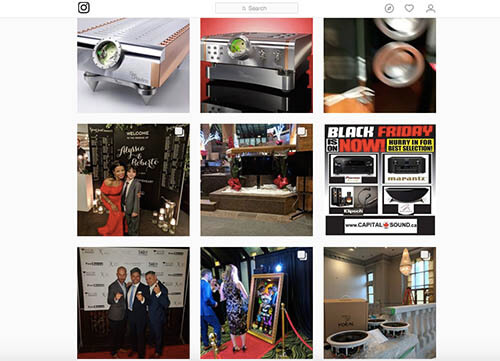
Romeo has read up on the topic to learn how to post, what to post, and when. On Instagram, he aims to post once per day, focused on putting a face and personality behind the brand. “If you’re just promoting and trying to sell something, it turns people off,” he says. “We don’t want to make it look like advertising.” In fact, Romeo believes that personal posts can add a level of authenticity to a page. He notes that a video from his son’s piano recital, which is peripherally related to his business on the music side, got more views than any other post.
But he also posts things like feedback on a speaker he recently tested and loved. And he has seen results, noting that at least once a week, he’ll get a call, or someone will come into the store, mentioning having seen an Instagram post, even if it was months prior. Consistency keeps the company top-of-mind. “If I get just one client,” he says, “it’s good, because the return on those is several thousands of dollars.”
Tony Scaffeo, Owner of The Scaffeo Group, which conducts eight-hour workshops showing businesses of all kinds how to use social media, believes retailers should be marketing, not prospecting. “You have to go out and grab that customer and bring him into your door,” he says, especially in light of growing competition online. Rather than focus just on company brand pages, he teaches business owners and leaders to empower their salespersons to organically promote the company through their own personal social media profiles. “You can’t force anyone to do it,” he says, “but for the people who do, the success rate goes up.”
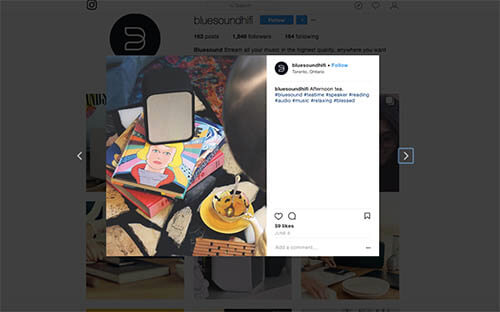
On the manufacturer side, Pickering, ON-based speaker company Bluesound has 10,000 Facebook Likes 1,800 Instagram followers, 3,091 Twitter followers; and 2,044 followers of its parent brand, The Lenbrook Group of Companies, on LinkedIn. The NAD Electronics brand has an impressive 20,000 loyal Facebook fans and 12,520 Twitter followers.
June Ip, Vice President of Marketing at Lenbrook, says NAD’s Facebook audience is highly engaged and loyal, so the primary goal is awareness and loyalty building; and finding a new way to connect.
“[We want] the fans on that channel to feel like they have insight into the brand,” she notes. A recent campaign encouraged fans to share videos about the first NAD product they ever owned, discussing what they remember about it. “Those stories really help people connect with the brand more,” she says, and to see that there’s a community of people who love the products, and have the same good memories that they associate with this brand.
Since the Bluesound brand is relatively new, the strategy is to get curious users interested in finding out more. Thus, much of the content posted on Bluesound’s social media channels is centred around music discovery, and trying to find common ground with users that stumble upon the page.
“It’s a different purpose for each channel and each brand,” says Ip, “and a different approach for each because the audiences are so different.”
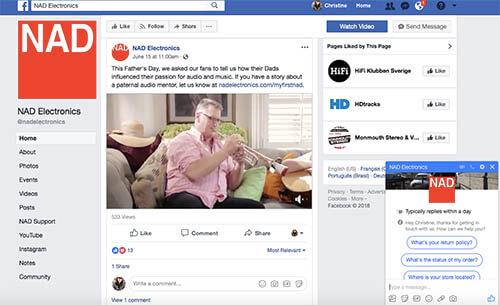
Lenbrook has a team that handles social media content and monitoring, and does paid placements as well as relies on organic reach. Because many social media sites throttle content, Ip believes that buying ads or boosting posts is a necessary investment.
“The beauty about social media,” she says, “is that you can target very specifically to certain audiences, and even geographies.” In urban areas, you might see a resurgence in vinyl, and want to tailor content to that trend, while in suburban areas with large boomer populations, content about CD players is more likely to get traction. “You can customize things specifically, and make sure your spend is very efficient.”
Vancouver-based speaker company Kanto Audio has a strong presence on Instagram with close to 4,000 followers, and Facebook with more than 15,000 Likes of its Page. On Facebook, says Annie Friesen, Marketing Coordinator, posts include articles, reviews, and images of Kanto products in retail stores. “It’s more of an information hub,” she says. On Instagram, the content is more curated. “We think of it almost as our brand catalogue.” Kanto runs contests on both sites, and posts at least once a week on Instagram, and 1-2 times per week on Facebook. While they don’t spend too much time on Twitter, Friesen says the site is a good sounding board for people who ask questions. YouTube, meanwhile, is used for installation and walk-through videos, which come out once a month or so.
With two full-time staff members in charge of managing social media, Friesen says they spend about 30% of their work week on it and use social media management tool Hootsuite to aid in the posting process.
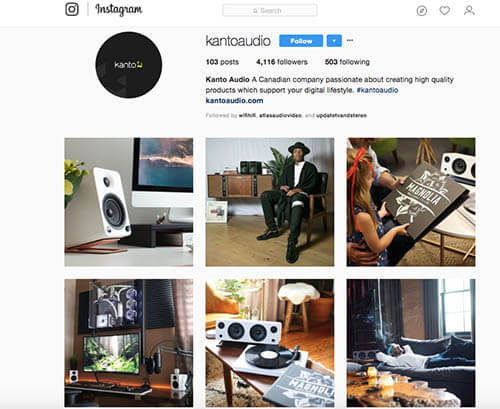
An interesting perspective comes from B2B retail security solutions company Halo Metrics.
“It was initially a bit of a challenge for us to understand how to use social media,” says Marketing Manager Ravinder Sangha. “My sense was that social media was great for companies that wanted to reach out to the masses, specifically business-to-consumer. But we are selling to retailers, and executives who work for retail businesses.”
The company decided to leverage the power of social media to promote its thought leadership, and turned mainly to YouTube, LinkedIn, and Twitter. This June, Halo Metrics celebrated surpassing 10,000 subscribers to its YouTube channel, which provides a series of informational videos highlighting the most frequently stolen items in stores, and comedic skits from a “professional thief” character they created named Troy. Attempting to put a positive spin on the scary issue of loss prevention, Troy is a hapless thief who thinks he has it all figured out, yet keeps failing miserably every time he tries to steal something in a store (thanks, of course, to Halo Metrics’ security solutions.) One of the videos, entitled “Professional Thief Makes Christmas Things to Steal List,” went viral, receiving more than 3.5 million views. The latest in the series was offered in virtual reality (VR), and presented at trade shows where attendees could wear VR goggles and try to pinpoint several thieves in a store in order to win a $1,000 prize.

Most of Halo’s videos are produced in house, intentionally to showcase a level of authenticity. But the company hires freelance videographers and editors for the Troy series, which they produce annually.
Across other social media platforms, Halo highlights content like blogs, and occasionally runs contests. On LinkedIn, the company participates in professional communities, sharing blogs, weighing in on conversations, and promoting events they are participating in. This, says Sangha, can help with professional networking.
In addition to brand building, Sangha has found another benefit to social media participation: having a lot of quality content online helps with search engine optimization (SEO). “Depending on how search engines rank, they will sometimes put the social media piece up first in the results,” he observes. “So…we try to put more interesting content and thought leadership out on those channels.”
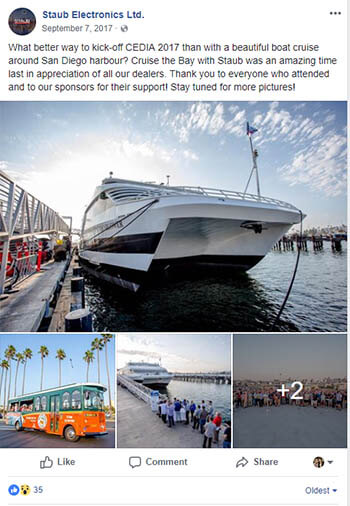
B.C.-based AV and custom installation products distributor Staub Electronics, which similarly deals predominantly with vendors and integrators, has also found value in social media, mainly using Facebook (556 Likes), Twitter (383 followers), and LinkedIn (325 followers) to reach customers. Diane Choi, Marketing Coordinator, says she is considering adding Instagram to the mix since a lot of dealer partners show off their work and projects there.
Choi spends a few hours posting about 2-3 items weekly, including product promotions, events, fun posts about Staub culture, contests, and industry news. She speaks with business development managers as well to get feedback on what would provide value, and crafts posts around their insight. She admits it’s more challenging for Staub then it might be for a consumer-facing company, since industry members tend to consume more content than they engage with. But “we want to do the best to keep our customers informed,” she says, “and we use our social media channels to support our brands, as well as get insight on what’s happening in the market, and how we can stand out.”
Also based in B.C., mobile accessories and audio products distributor Hitfar has a good presence across all major social media sites: 285 Instagram followers, 1,420 Facebook Likes, 259 LinkedIn followers, 497 YouTube subscribers, and 504 Twitter followers. Olga Romanenko, Marketing Manager, spearheads the marketing team’s initiative to post at least once per week, and says sites like Facebook help establish the company’s personality, message, and credibility across Canada. Social media can also help generate business leads, she notes, giving you more opportunity to convert.
Posts include product photos and videos, blogs, event photos, and contests. In a recent video series celebrating the company’s 30th anniversary, Hitfar representatives meet with friends, retail partners, and employees to share their thoughts on business. Romanenko believes that while having a high number of followers is important, what’s critical is that they represent a reflection of an engaged community.
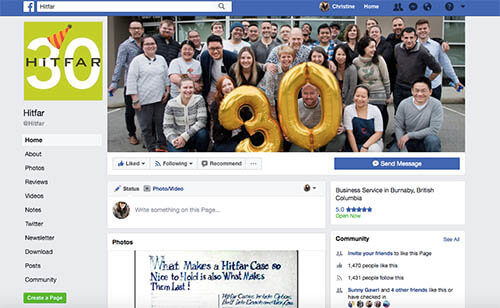
Building a Social Media Strategy
You can work with third-party companies like TrackMaven, Influitive Marketing, Hootsuite, and TailWind to build a comprehensive strategy for social media. Many Web developers now count social media management as part of their offerings as well.
For those handling things in house, social media can be a massive undertaking, particularly as an added task for an already likely overworked marketing team, or small business owner. But it’s one that, as the companies surveyed above prove, can be done successfully by simply committing some time to keeping on top of things.
While managing pages and accounts is crucial, it’s also about being responsive to customers, clients, and fans, and actively contributing to conversations, on your pages and beyond.
“It’s important,” says Romeo, “that manufacturers are also on their A-game, posting new products online. But us retailers should be liking those, following the manufacturers, and commenting actively on the posts.”
He cites an example of when he commented on a post from Klipsch about its Heritage soundbar, which won awards at the Infocomm trade show a few years back, inviting anyone from the Ottawa area to come have a listen is his new showroom. Klipsch replied, congratulating him on the opening, and equally encouraging locals to visit. “I’m hoping we’re going to receive some reciprocal people calling or coming into the shop,” says Romeo, and that his comment encourages others on the conversation string to begin following his account as well.
TrendSpotter is one of many companies that helps brands predict social trends, and monitor things like influencers and hashtags so that companies can not only work on manning their own official accounts, but on being responsive to posts about their brand as well.
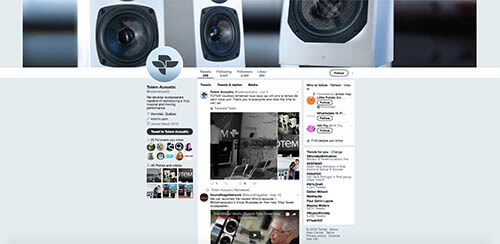
“People are there to have their voices heard,” says Friesen, “and we need to speak back to them. We have to make sure that what we’re putting out there, we have the bandwidth to give feedback as well. It’s a privilege to have people comment back at us, and we have to make people feel good about interacting with us. Social media is very community-based.”
Like many others with whom we spoke, Choi says participating in social media helps Staub build a sense of community with its vendors, dealers, and consumers who are interested in AV technology. “We keep our purpose in mind of helping integrators succeed when posting on social media, and the audience in mind in each social media platform when we create and share a post.”
Once you have an active audience you can reach at any moment, the goal, says Sangha, is to continue to grow that community. And to cultivate that, “you have to provide useful and meaningful content that keeps them engaged.”
“People don’t just go to the store and buy anymore,” adds Friesen. “They’re looking on their phones for reviews, and looking to social media to feel better about their purchase, and see if what they’re buying is within their friend circle. We want people to see us on social media and say ‘wow, that’s a really good-looking product and people are using it and talking about it; for people to look on social media and see that there are 4,000 other people who also like this, and ‘here’s this person playing it with their records and they really like it, I think I might like this, too.’”

Friesen admits that while it’s tough to determine strict ROI, Kanto has observed spikes in sales in the months they are more active on social media. And retailers are noticing, too. “They appreciate it,” she says. “I know from speaking with the sales team when they go out and pitch products that retailers are looking at social media, and they are also starting to go on social media [themselves]. And we can help them as well.”
The New (And Very Public) Customer Service Hotline
There is, however, a dark side to social media. Anonymous “trolls” can hide behind a veil of abstract user names and fake e-mail accounts to spew hate and vitriol. And companies can be legitimately held accountable for bad behaviour very publicly with a video, post, or even hashtag. But brands can also use social media to direct a favourable conversation that resonates positively with customers.
Ip says a good chunk of the Lenbrook team’s time on social media is spent answering customer questions. And she finds Twitter to be a good platform for this type of interaction.
“There’s a certain immediacy to Twitter that you don’t find on other social networks,” she says, adding that it’s an “important channel for real-time conversations with customers.”
While a dedicated customer service team is still required, notes Friesen, it’s important for the social media and customer service teams to work together to ensure that customer inquiries are answered in the same forum in which they’re asked.
It’s a great customer relationship management tool, adds Choi because it’s instant, and two-way. Romanenko, too, believes that social media is great for building a relationship of credibility and trust with customers. “And it makes your business more accessible for new prospects. We love using social media as a back channel communication because it creates transparency.”

The key, says Sangha, is to be authentic, whether a customer is extolling your virtues or calling you out. “It’s almost like a public response to a public issue,” he notes. “Don’t fake it. Be true to your organization, and brand, and deal with people in an upfront and positive way.”
You never want to be caught in a situation where you’ve said one thing and your actions haven’t followed through. “Things can be magnified on social media if it comes across as phony,” he says. (Remember when musician Alicia Keys posted a Tweet with the clear “Twitter for iPhone” tag on it shortly after having been named a brand ambassador for BlackBerry? Oops!)
Is Social Media for Every Business?
Companies selling military weapons to governments probably don’t need a Facebook page. But for most businesses selling goods and services to customers, whether those customers are other businesses or end users, there’s value in having a social media presence.
Social media has the power to reach more people than you could ever achieve through other avenues. And it also has the power to make or break a brand. Which is why getting on board can be a scary, but also necessary, proposition to control and manage your message versus putting it in the hands of others.
Scaffeo believes social media naysayers who shrug it off as BS are simply afraid of the tool. “They just don’t understand it,” he says. “And it’s funny because an old guy like me gets in front of Millennials and teaches them how to use this stuff.”
Once you’ve made the decision to put your brand out there in social media, it’s essential to commit fully to it. This isn’t a dip your toes in and test the waters deal.
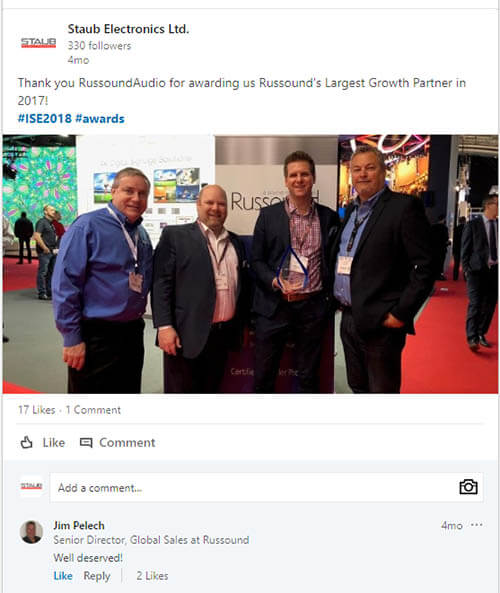
“If you aren’t doing it properly, and can’t give it the time it needs, don’t do it,” says Friesen. “The saddest thing is to have a profile with no activity on it.”
It doesn’t require dedicating hours every day to posting content. Start with one or two sites, such as Facebook or Instagram, and post something compelling at least once a week: a single photo and caption, perhaps of a new product that just came in; a post about a sale, or a fun musing. Add relevant hashtags to make the post searchable. When you have a few spare moments, look for partner and related brands, enthusiasts, and fans, and connect with them. And empower someone in the company to check in every now and then, and respond to customer inquiries or comments. Romanenko suggests strategically selecting what and how many social media channels to run based on your resources.
Consider, when budgets allow, complementing your reliance on organic reach with paid advertising, even if it’s just a couple hundred dollars a few times a year for a boost. Once you have a solid and engaged audience, reaching more people organically will become easier.
“Social media is a really good place to show customers that you care about them, and you’re listening,” says Friesen.
“You can’t just half-heartedly do social media,” agrees Sangha. But you also can’t, nor shouldn’t be, intimidated by it. Come up with a do-able starting plan based on resources, commit to it, and it will be less of a nuisance over time as it becomes a part of your daily flow.
We might not like social media. We may even detest what it has done to the nature of community and conversation. But the reality is that it isn’t going away. So it’s time to embrace it, and allow it to work to your advantage, instead of against you.








